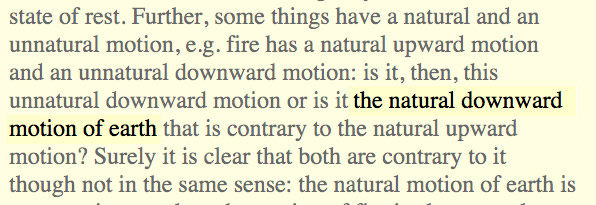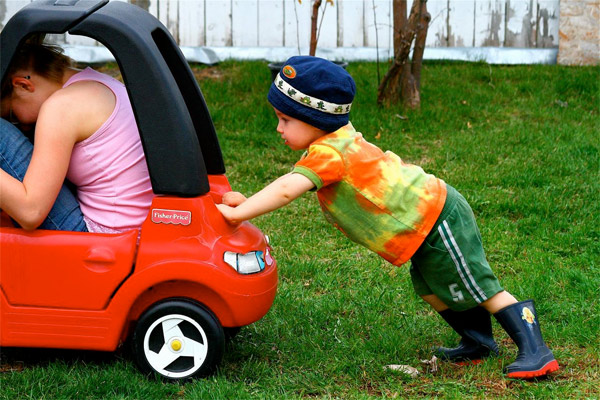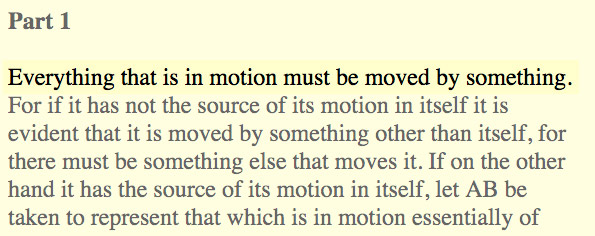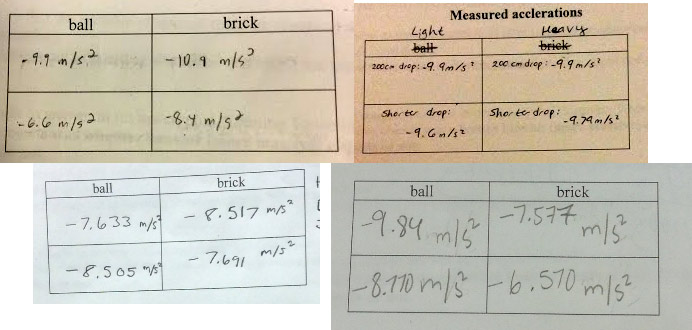How things move
What is the "common sense" way that things move?
Vertical motion
Falling objects seem to drop effortlessly with no human push/effort needed
to keep them moving.

Aristotle (end of book V):

...believed it was "natural" for one piece of earth to move down to unite with the bigger piece of earth.
Horizontal motion

In many situations, it seems that once someone stops pushing
on an object, the object will stop moving.
Aristotle (Beginning of book VII):

Not "must *have been* moved by something" but "must be moved by something".
Aristotle thought of rest as the natural state for objects on a surface, and that motion ("violent" motion) required some outside agent to move an object.
Violent motion: It seems that effort is required for horizontal motion, whether it be dragging a load or throwing a stone. Aristotle viewed this effort as arising because of the difficulty in getting objects to do something other than what was natural. (See 'natural motion' above!)
How do we talk nowadays about effort?
Celestial motion: The stars appeared to move in circles in the firmament without external assistance, and yet not towards the earth. This is not in conflict with "violent" motion which requires continued effort: Because different rules apply in the earthly and heavenly realms.
"Effort"
What Aristotle talked about as "effort" we might nowadays call a "force". An operational definition:
A force is something that can stretch or compress a spring.
The force that gravity exerts on an object is called it's weight.
Certainly the force on heavy and light objects is different so it seems reasonable to expect that they might fall differently. We are exploring this question by looking at the way the positions and speeds of free falling objects change with time.
Speed
average speed (symbol '$v$') = distance travelled / time to travel $$ v = \frac{d}{t}$$
Or, an equivalent definition that makes the connection strong to the slopes we measured on graphs of distance vs time: $$v = \frac{\Delta d}{\Delta t}.$$
Velocity
velocity = speed and direction of travel
In physics we write velocity as $\myv v$ and speed as $v$.
Jane passes Fred, both of them moving North on 8th Street.
- Do they have the same speed?
- Do they have the same velocity?
Jane and Fred pass in opposite directions, both going 15 km / hour.
- Do they have the same speed?
- Do they have the same velocity
Acceleration
Acceleration: any change in an object's velocity. $$\text{acceleration}=\frac{\Delta v}{\Delta t}.$$
What is the acceleration of a car moving along a straight highway with a constant speed of 30 mph?
For motion in a straight line, we will usually be interested in the ratio of the change in speed ($\Delta v$) to the time ($\Delta t$) during which the speed change happens.
Results so far for accelerations...

Practice
Practice this with this in-class exercise about acceleration.
It looks like acceleration can also be thought of as the slope on a graph of $v$ vs $t$.
Galileo's ramps
Galileo realized that friction plays a roll in how objects behave. So he tried to minimize friction:
- balls roll easier than bricks slide.
- heavy balls don't seem to be affected as much by air resistance as lighter ones.
- hard balls roll easier on hard surfaces than flexible balls or soft surfaces.
If you start a ball rolling up an incline it slows
down.

If you release a ball to roll down an incline it speeds
up.

So, what behavior is "half way" between slowing down and speeding up?

[motion at a constant speed! That is... acceleration=??]